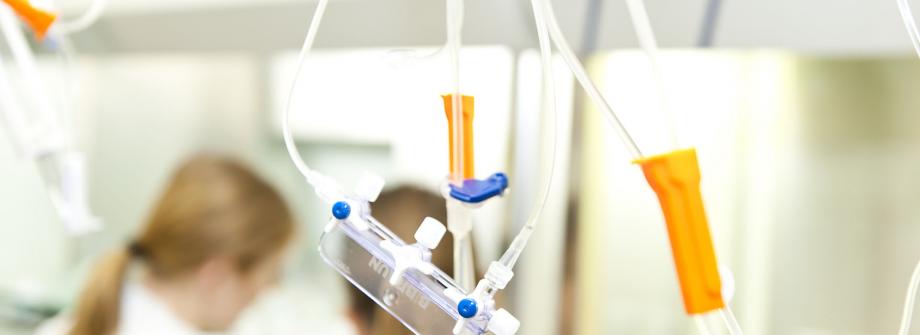
March 2023 Clinical Case of the Month
Title: Selection of cord blood unit in an emergency donor search at the beginning of the COVID-19 pandemic
Submitted by: Andrea Acerbis, MD
Hematology-Oncology Fellow
Università Vita e Salute San Raffaele
Milan, Italy
Physicians expert perspective: Annalisa Ruggeri, MD, PhD
Hematology and BMT Unit
IRCCS San Raffaele Hospital
Milan, Italy
A 43-year-old male, diagnosed with acute B-cell lymphoblastic leukemia (B-common phenotype, very high risk karyotype), in first complete remission with negative minimal residual disease (MRD), was scheduled to undergo an allogeneic hematopoietic cell transplantation from a 10/10 HLA matched unrelated donor (MUD) from Germany, in San Raffaele Hospital in Milan, Italy.
A conditioning regimen based on fludarabine (40 mg/m2 from day -5 to -2) and fractionated 12-Gy total body irradiation (TBI) given twice-daily from day -3 to -1 was administered. Unfortunately, at day -3, his unrelated donor became unavailable for SARS-CoV-2 positivity, with upper respiratory tract symptoms. No patients family members were available, as potential donors, and his parents were more than 70 years old with comorbidities. We therefore started a search of cord blood unit, and two potential cord-blood units were urgently identified.
Donor 1: female. HLA-match: 6/8. One antigen mismatch in HLA-A and -B. CD34+ cell dose: 1.5x105/kg. TNC dose: 2.7x107/kg. Unit collected in a FACT-accredited hospital in Milan (IT) in 2014.
Donor 2: male. HLA-match: 6/8. One antigen mismatch in HLA-C and -DRB1. CD34+ cell dose: 1.8x105/kg. TNC dose: 2.9x107/kg. Unit collected in a FACT-accredited hospital in Madrid (ES) in 2019.
Which of the following statement is correct?
A. Donor 1 is to be preferred over Donor 2
B. Donor 2 is to be preferred over Donor 1
C. Both Donors are equivalent and can be selected based on logistic considerations
D. There are some missing information, donors have to be selected according to ABO blood group and cytomegalovirus (CMV) serology
Expert Perspective by Annalisa Ruggeri
This case represents an urgent and dramatic situation faced by clinicians working with very aggressive diseases at the beginning of the COVID19 pandemic. In late February 2020 the first Italian patient was tested positive and soon after the spread of the virus affected globally the entire world. This case describes a very challenging situation occurred at the beginning of the COVID outbreak, when general measurers for the management of high-risk patients, were not yet established. National and international recommendations released when the lockdown measures were organized, recommended to proceed with the cryopreservation of the graft before starting the conditioning regimen, and to plan a backup donor work up.
In our case, the prompt search for a further donor was mandatory, and the cord blood unit inventory available worldwide was the best rescue we may offer to the patient, with no risk for the donor and immediate availability from accredited cord blood bank.
When selecting the UCB unit, the cell dose, namely the cryopreserved TNC, content and the HLA matching are the standard requirements for the choice of the appropriate UCB unit. Several different studies confirmed that, for patients with malignant diseases, the mainly recommended threshold for TNC is 2.5-3×10e7/kg and for CD34+ cell dose is 1-1.5x10e5/Kg at cryopreservation, with no evidence of further benefit with increasing TNC doses >5×10e7/kg1.
Low resolution HLA matching for UCB units is generally based on 3 loci (HLA-A, -B at antigenic level, and -DRB1 at allelic level), with a maximum of 2 out of 6 HLA mismatches being considered acceptable, as a higher incidence of NRM is associated with greater mismatches. More recently, in a study analyzing the effect of the HLA C on UCBT, Eurocord and NMDP/CIBMTR2 reported higher NRM in patients receiving an UCB unit with a mismatch at HLA locus-C. In addition, concomitant mismatching at HLA-C and -DRB1 was associated with the highest risk of mortality. Later, a collaborative study from the same group3 analyzed the effect of full allelic typing for HLA-A, -B; -C; and –DRB1 on UCBT outcomes, reporting significant reduction in mortality for well-matched donor.
In summary, while both cord blood units had high cell dose content for both TNC and CD34+, the correct answer is the A. Avoiding mismatches in class II HLA, is required to reduce the risk of graft failure and non-relapse mortality. Given the recent finding available in literature, high resolution HLA typing is available for the banked cord blood units, including HLA locus C, and this is a further option to improve cord blood transplant outcomes.
Correct Answer – A
References
1. Ruggeri A. Optimizing cord blood selection. Hematology Am Soc Hematol Educ Program. 2019 Dec 6;2019(1):522-531. doi: 10.1182/hematology.2019000056
2. Eapen M, Klein JP, Sanz GF, et al. Effect of donor-recipient HLA matching at HLA A, B, C, and DRB1 on outcomes after umbilical-cord blood transplantation for leukaemia and myelodysplastic syndrome: a retrospective analysis. Lancet Oncol. 2011;12(13):1214-1221.
3. Eapen M, Klein JP, Ruggeri A, et al. Impact of allele-level HLA matching on outcomes after myeloablative single unit umbilical cord blood transplantation for hematologic malignancy. Blood. 2014;123(1):133-140.
Future Clinical Case of the Month
If you have a suggestion for future clinical case to feature, please contact Anna Sureda.